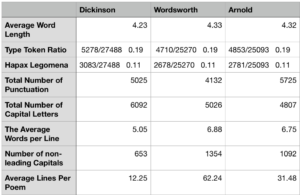The aim of this aspect of the project is to examine and address the era of poetry Emily Dickinson’s poetry. Dickinson’s poetry was not boxed in one of the periods that were present during her lifetime. This is due to a number of reasons, such as how the vast majority of Dickinson’s works were not published during her lifetime, making it hard to assess the exact dates of many of her poetry. Dickinson is also known for the unique style of her works, which would help to further place her somewhere outside of the borders of traditional eras. The way this project approached this is by comparing stylistically which kind of poetry Dickinson is more similar to.
During Dickinson’s lifetime two genres of poetry were present, the Victorian and the Romanticism eras. Romantic poetry took place during the late 18th and early 19th centuries. This era of poetry was defined by emotion, inward reflection and spontaneity. The Victorian era, 1837-1901, instead ended up focusing more on ideas of the everyday life including injustices within society. With these eras having an overlapping time period in Dickinson’s life, it would be hard to determine Dickinson’s poetry as one of these periods only as she wrote a variety of poems about different topics. Dickinson also wrote in ways that deviated from the traditional way of poetry, such as experimenting with rhyme and meter.
This project instead chooses to examine the ways that Dickinson’s poems were similar to these eras using quantitative data. Dickinson poetry was compared to William Wordsworth’s and Matthew Arnold’s poems, famous Romantic and Victorian poets. Both of these poets were well known within the genres.
To do this a computer analysis program was created that compared nine key things in structure of the poems. For each poet a collection of over 70 poems was imputed for each. The sum of the poems collectively was around the same word count, only about 100 words separating each. This program found things like the average lines per poem, average words per line, total number of punctions, and more. It was expected that that Dickinson’s poetry would be more similar to Romantic era poetry as Dickinson uses the senses and emotion strongly in her poems. It is also hypothesized that Dickinson would have a higher number of punctuation than the other poets, more capital letters, and shorter line count per poem. What the data showed was both similar and different than expected. The results can be seen below in Figures one and two.

Figure one

Figure 2
Looking at figure one, Dickinson is only similar to either of the other poets in three of the analyzed aspects. The things that were similar were average word length, Type Token Ratio, and Hapax Legomena. When Dickinson’s poetry was similar to one type, she was also similar to the other. The only place this is not true is in total number of punction as she is more similar to Arnold. Dickinson’s average word length is off by around .1 to the other two poets but it shows that most words were around four letters
Type token ratio refers to the number of different words in a text to the total number of words in that text and Hapax Legomena is the number of words that occur exactly once in the text to the total number of words in the text. In the chart the rounded decimal is shown as well as the fraction. This is interesting that they would all be the same because the average line per poems is vastly different, as Dickinson has only around 12 lines per poem and Wordsworth and Arnold have around 62 and 31. This would mean that as a whole they all had around the same number of original words and words that only appear once.
Looking at the differences from Dickinson to the other poets is immense as her works don’t seem to be around the same in any of the other aspects. In fact, looking at the data it appears that Wordsworth and Arnold are more similar to each other than to Dickinson. While the data is not lined up perfectly the average words per line, number of non-leading capitals, average word length and average lines per poem are the aspects where they are more alike to each other. In Chart two, we can see that in the top 5 most used words, four of them are similar and the first three match up in places of most used. Dickinson in comparison only has two similar words to Arnold and three with Wordsworth.
It was proven incorrect that Dickinson would have the most punctation, and most non-leading capitals. It was shown to be correct that Dickinson had the most capitals of all the poems. The most unexpected part of the data was that the other two poets were closer to each other than to Dickinson.
Looking at this data it is significant to note that Dickinson was not very structurally similar to the other poets. This sets her apart as it shows how even in her style, she is unique. It is also significant to note that instead what was expected it was found that Wordsworth and Arnold were surprisingly similar in many aspects. What was learned from this project is that Victorian and Romantic era poetry could be more similar structurally than expected. More research would have to be done to confirm this, as both Wordsworth and Arnold are not the only poets in their genres, but structurally the style is at least somewhat more similar to each other than to Dickinson. In the future more research could be done with multiple Romantic and Victorian poets in comparison to Dickinson.